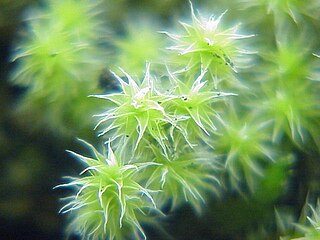
Toona ciliata is a forest tree in the mahogany family which grows throughout South Asia from Afghanistan to Papua New Guinea and Australia.

Elsholtzia ciliata, commonly known as Vietnamese balm, xiang ru (香薷) or kinh giới in Vietnamese, is a plant native to Asia. In the US, it is commonly known as Crested Late Summer Mint. In US Vietnamese grocery stores, it is called Kinh Gioi, Vietnamese Lemon Balm, or Vietnamese Lemon Mint.

Pier Andrea Saccardo was an Italian botanist and mycologist. He was also the author of a color classification system that he called Chromotaxia. He was elected to the Linnean Society in 1916 as a foreign member. His multi-volume Sylloge Fungorum was one of the first attempts to produce a comprehensive treatise on the fungi which made use of the spore-bearing structures for classification.

Lysimachia ciliata, the fringed loosestrife, is a species of flowering plant in the family Primulaceae. It is an erect herbaceous perennial growing to 120 cm (47 in) tall and 60 cm (24 in) broad, with opposite, simple leaves, and smooth green stems. The star-shaped yellow flowers are borne in midsummer. It is native to North America, including most of southern Canada and most of the United States except for the southwest. This plant is notable in that it is one of the few species of Lysimachia to bear elaiophores, that is, to offer oil instead of nectar as a reward to pollinators. It is pollinated in the northern part of its range by the specialist oil bee Macropis nuda, a native bee species whose survival depends upon this host plant.

Hygroryza (watergrass) is a genus of Asian plants in the grass family.
Heinrich Simon Ludwig Friedrich Felix Rehm was a German mycologist and lichenologist. He studied at the Universities of Erlangen, Munich and Heidelberg, earning his medical doctorate in 1852. During his career, he was a practicing physician in Dietenhofen, Sugenheim, and Windsheim. In 1875, he became regional medical examiner in Lohr am Main.
Sandeothallus is a small genus of liverworts restricted to East Asia. It is classified in the order of Pallaviciniales and is the only member of the family, Sandeothallaceae within that order.

Populus ciliata, the Himalayan poplar, is a large deciduous tree with tall clean straight trunk and wide rounded crown. The bark of the young trees is smooth greenish-grey and the bark of the old trees is dark brown with vertical cracks. Leaves are broadly ovate with serrulate-crenate and hairy margins. Flowers are drooping raceme catkins appear before or with leaves. Populus ciliata flowers are dioecious, individual flowers are either male or female. Perianth of male flowers is bell-shaped and female flowers are bluntly toothed. Their capsule encloses an average of 100–150 seeds, which are covered by long silky hair.

Blephilia ciliata is a species of herbaceous perennial plant in the Lamiaceae (mint) family native to central and eastern North America. It is commonly called downy wood mint. Other common names include downy pagoda-plant, sunny woodmint and Ohio horsemint.

Coprosma ciliata, is a shrub in the family Rubiaceae that is endemic to New Zealand. C. ciliata is found in the South Island from Lake Brunner southwards into Fiordland mostly west of the Southern Alps. The species prefers lowland forest where it often occurs beside streams, swamps and lakes.

Hedwigia is a genus of mosses belonging to the family Hedwigiaceae.
Alan W. Archer is a mycologist and taxonomist. He is currently an honorary research associate at Royal Botanic Gardens Sydney. He uses chemotaxonomy as well as morphological features in taxonomy and to devise keys, most recently for the genus Pertusaria in the Australasia region.

Ciliata septentrionalis is a species of fish belonging to the family Lotidae.
Pannaria aotearoana is a species of lichen in the family Pannariaceae, first described in 2016 by Arve Elvebakk and John Elix from a specimen found on a Coprosma linariifolia in the South Island of New Zealand.

Phlebocarya ciliata is a plant in the Haemodoraceae family, native to Western Australia.
Goebeliellaceae is a family of liverworts belonging to the order Porellales. The family consists of only one genus: GoebeliellaSteph..
Grolleaceae is a monotypic family of liverworts belonging to the order Jungermanniales. The family consists of only one genus, GrolleaR.M.Schust.. It has only one known species Grollea antheliopsisR.M.Schust. from South America.
Hedwigiaceae is a family of mosses belonging to the order Hedwigiales.
Lepicoleaceae is a family of liverworts belonging to the order Jungermanniales.











